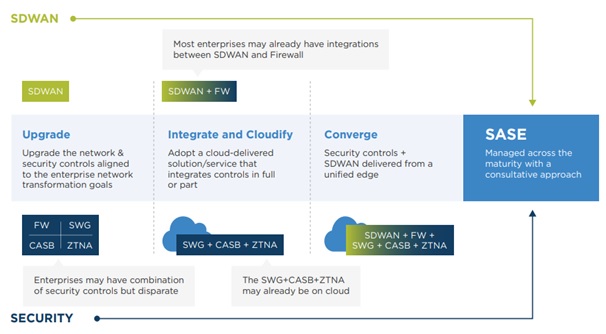Enterprises today are re-evaluating traditional networks and increasingly adopting new technologies such as software-defined wide area network (SD-WAN) for reliably connecting distributed resources. Massive network expansion and device proliferation is making cloud enablement, robust cybersecurity, and seamless orchestration and interoperability critical for organisations, especially in fragmented operational landscapes. In this article, Rajarshi Purkayastha, Head of Pre-Sales in the Americas for Tata Communications, explores the role of secure access service edge (SASE) technology for enterprises.
SASE combines security and a modern network as service capabilities to ensure seamless connectivity and data protection without compromising on user experience. And its growing emphasis can be gauged by increasing industrial acceptance. As per Gartner’s SASE Forecast Analysis1, the global market for SASE is expected to be worth $15 billion by 2025, growing at a remarkable CAGR of 36% since 2021. This blog covers the basics of SASE and how it can empower enterprises towards the future.
The larger aspect of SASE and its significance
SASE represents a holistic framework that unifies wide-area networking (WAN) and network security within a single cloud-based service approach. It ensures secure access to applications and resources for users, irrespective of their location, device, or network, by delivering integrated security and networking service capabilities including SD-WAN, SWG, CASB, NGFW and Zero Trust Network Access (ZTNA).
 As remote operations and cloud service usage grow, SASE provides a convenient, fast, cost-effective, and scalable solution for networking and security. Reports indicate that 60% of enterprises will have definitive strategies and timelines in place for SASE adoption by 2025, up from 10% in 2020, highlighting enterprise urgency in adopting SASE for their short- and long-term operational goals.
As remote operations and cloud service usage grow, SASE provides a convenient, fast, cost-effective, and scalable solution for networking and security. Reports indicate that 60% of enterprises will have definitive strategies and timelines in place for SASE adoption by 2025, up from 10% in 2020, highlighting enterprise urgency in adopting SASE for their short- and long-term operational goals.
Here are some of the defining traits of SASE that create a differentiator:
- A holistic framework: The SASE framework is built on multiple technologies and combines various components to develop a unified platform that can drive operations seamlessly across environments, endpoints, and locations. While SASE depends on software-define networks, it is more than just revolutionised SD-WAN or a point product. Instead, SASE is an end-to-end approach to connecting data, applications, and users, and in the process, offering improved flexibility, scalability, and security to enterprises.
- Strategic integrations: Due to the incorporation of various technologies from different vendors, the framework’s true strength lies in the proficiency of its integration. The engineering complexities involved in harmonising technologies from different sources into a unified solution are substantial. However, SASE facilitates this integration offering a well-rounded computing solution aligned with the changing business and digital paradigm.
- Immersive experiences: SASE integrates security and network functionality to enhance application, end-user, and administrative experiences within its technological framework. The ultimate objective is ensuring every user or endpoint enjoys access to the required resources securely and efficiently.
Unlocking SASE benefits with intelligent adoption
Enterprises must adopt SASE strategically and think beyond addressing the present challenges and opportunities towards the future of work. For them, successful adoption of SASE would hinge on:
- A clear understanding of the objectives
- Setting network performance targets
- Preparing for multi-cloud connectivity
- Emphasising secured branch networking and security tooling
- Modernising applications
- Servicing and measuring progress regularly.
Even though SASE brings an architectural shift, organisations might also consider implementing the foundational elements of its architecture and subsequently enhance it through gradual, intentional steps. Here are some of the key benefits the architecture offers:
- Convergence of technologies: The SASE framework emphasises combining various technological innovations and augmenting human capabilities. A common framework to analyse users, applications, and data enables faster issue resolution and informed decision-making.
- Improved IT efficiency: With fast deployment, centralised orchestration, and analytics-driven role-based management, SASE promises to offer the enterprise IT teams greater observability and control. This results in improved decision-making and enhanced IT effectiveness.
- Improved and secured remote access: SASE delivers user-centric security, avoids traffic backhauling to policy enforcement points, and optimises user experience by anchoring clients to the right SASE gateway. This reduces latency and helps detect malicious traffic to intervene and prevent threats.
Managed SASE is the way forward
 Despite its benefits, enterprises are often daunted by the large-scale architectural changes and implementation challenges of SASE adoption. As a result, a plug-and-play approach with point solutions are often preferred. However, the key tenet of SASE is holistic transformation that facilitates secure and value-based outcomes, which is ideally a major value proposition that a managed service provider (MSP) can bring to the table. Drawing from experiences across various industries, MSPs exhibit adaptability and flexibility, resulting in cost-effective and swift deployments as well as issue resolution with their consultative approach.
Despite its benefits, enterprises are often daunted by the large-scale architectural changes and implementation challenges of SASE adoption. As a result, a plug-and-play approach with point solutions are often preferred. However, the key tenet of SASE is holistic transformation that facilitates secure and value-based outcomes, which is ideally a major value proposition that a managed service provider (MSP) can bring to the table. Drawing from experiences across various industries, MSPs exhibit adaptability and flexibility, resulting in cost-effective and swift deployments as well as issue resolution with their consultative approach.
MSPs elevate network performances by underlaying infrastructure and providing unified management of underlay and overlay within a single managed service. With a single point of accountability, MSPs take responsibility for service chaining, integrating multiple virtual network functions, and implementing future technology upgrades. They also offer continued support and training, progress management services, and future planning, making SASE implementation a truly end-to-end process. By opting for a managed SASE solution, organisations can significantly reduce initial investments and operational overhead, freeing up in-house IT for more valuable tasks.
Doing it right with Tata Communications
At Tata Communications, we have designed our SASE offerings to be evolutionary, not just revolutionary. Our three-phased SASE approach involves meticulously thought out and tailormade security and network upgradations that are aligned with enterprise network transformation goals, thorough integration and unification on the cloud, and convergence of network functions and security solutions. Our Managed SASE offerings improve business agility, observability, and control, simplify network and security management, and reduce costs.

Learn more about how a managed service approach can help you build your SASE implementation right in our next blog post.
Sources:
- https://www.gartner.com/en/documents/4004092
- https://blogs.gartner.com/andrew-lerner/2021/03/26/checking-in-on-sase/
Transformational Hybrid SolutionsOur cloud-enablement services offer the best performance on your traffic-heavy websites or mission-critical applications.
Core NetworksTata Communications™ global IT infrastructure and fibre network delivers the resources you need, when and where you need them.
Network Resources
Unified Communications As A ServiceBreak the barriers of borders efficiently and increase productivity with Tata Communications’ UC&C solutions.
Global SIP ConnectEmpower your business with our SIP network and witness it grow exponentially.
InstaCC™ - Contact Centre As A ServiceCloud contact centre solutions for digital customers experience and agent productivity.
DIGO – Communications Platform as a ServiceDIGO is an in-network cloud communications platform, enabling you to power up converged contextual human-to-everything conversations globally.
Unified Communication Resources Case studies, industry papers and other interesting content to help you explore our unified communications solution better.
IoT SolutionsThe Internet of Things is transforming the way we experience the world around us for good. Find out more about our Internet Of Things related solutions here.
Mobility SolutionsTata Communications’ mobility services enable your enterprise to maintain seamless communication across borders, with complete visibility of cost and usage.
Mobility & IoT Resources
Multi-Cloud SolutionsWith enterprises transitioning to a hybrid multi-cloud infrastructure, getting the right deployment model that yields ROI can be a daunting task.
Cloud ComplianceCompliant with data privacy standards across different countries and is also designed to protect customers’ privacy at all levels.
IZO™ Cloud Platform & ServicesIZO™ is a flexible, one-stop cloud enablement platform designed to help you navigate complexity for more agile business performance.
Managed Infrastructure ServicesIntegrated with our integrated Tier-1 network to help your business grow efficiently across borders.
Cloud PartnersWe support a global ecosystem for seamless, secure connectivity to multiple solutions through a single provider.
Cloud Resources
Governance, Risk, and ComplianceRisk and Threat management services to reduce security thefts across your business and improve overall efficiencies and costs.
Cloud SecurityBest-in-class security by our global secure web gateway helps provide visibility and control of users inside and outside the office.
Threat Management - SOCIndustry-leading threat-management service to minimise risk, with an efficient global solution against emerging security breaches and attacks.
Advanced Network SecurityManaged security services for a predictive and proactive range of solutions, driving visibility and context to prevent attacks.
Cyber Security ResourcesCase studies, industry papers and other interesting content to help you explore our securtiy solution better.
Hosted & Managed ServicesTata Communications provide new models for efficient wholesale carrier voice service management. With our managed hosting services make your voice business more efficient and better protected
Wholesale Voice Transport & Termination ServicesYour long-distance international voice traffic is in good hands. End-to-end, voice access & carrier services which includes voice transport and termination with a trusted, global partner.
Voice Access ServicesTata Communication’s provide solutions which take care of your carrier & voice services, from conferencing to call centre or business support applications.
Carrier Services Resources
CDN Acceleration ServicesOur CDN Web Site Acceleration (WSA) solution helps deliver static and dynamic content, guaranteeing higher performance for your website.
CDN SecuritySafeguard your website data and customers’ information by securing your website from hacks and other mala fide cyber activities.
Video CDNDeliver high-quality video content to your customers across platforms – website, app and OTT delivery.
CDN Resources
Elevate CXIncrease customer satisfaction while empowering your service team to deliver world-class customer experience and engagement.
Live Event ServicesTata Communications’ live event services help battle the share if eyeballs as on-demand video drives an explosion of diverse content available on tap for a global audience.
Media Cloud Infrastructure ServicesTata Communications’ media cloud infrastructure offers flexible storage & compute services to build custom media applications.
Global Media NetworkTata Communications’ global media network combines our expertise as a global tier-1 connectivity provider with our end-to-end media ecosystem.
Use CasesUse cases of Tata Communications’ Media Entertainment Services
Remote Production SolutionsMedia contribution, preparation and distribution are highly capital-intensive for producers of live TV and video content, and their workflows are complex.
Media Cloud Ecosystem SolutionsThe Tata Communications media cloud infrastructure services offer the basic building blocks for a cloud infrastructure-as-a-service.
Global Contribution & Distribution SolutionsTata Communications’ global contribution and distribution solution is built to reduce capital outlay and grow global footprint.
Satellite Alternative SolutionsAs more and more consumers choose to cut the cord & switch to internet-based entertainment options, broadcasters are faced with capital allocation decisions.
LeadershipA look into the pillars of Tata communications who carry the torch and are living embodiment of Tata’s values and ethos.
Culture & DiversityHere at Tata Communications we are committed to creating a culture of openness, curiosity and learning. We also believe in driving an extra mile to recognize new talent and cultivate skills.
OfficesA list of Tata Communications office locations worldwide.
SustainabilityTata Communications adopts a holistic approach and harnesses the power of new-age technologies like 5G, IoT and AI to build a sustainable digital world.
FAQCheck out our FAQs section for more information.
BoardHave a look at our board of members.
ResultsFind out more about our quarterly results.
Investor PresentationsFollow our repository of investor presentations.
FilingsGet all information regarding filings of Tata communications in one place.
Investor EventsAll investor related event schedule and information at one place.
GovernanceAt Tata, we believe in following our corporate social responsibility which is why we have set up a team for corporate governance.
SharesGet a better understanding of our shares, dividends etc.
SupportGet all investor related contact information here.


